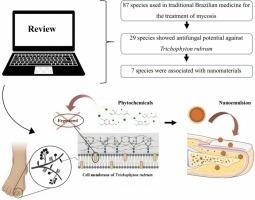Traditional use of medicinal plants in Brazil to treat mycosis, antifungal activity, and their nanomaterials against Trichophyton rubrum
IF 1.9
4区 医学
Q2 INTEGRATIVE & COMPLEMENTARY MEDICINE
引用次数: 0
Abstract
Introduction
Mycosis are health problems that affects the global population. Current treatments have used synthetic drugs with several side effects. To overcome these drawbacks, medicinal plants have been investigated as a promising alternative to this problem, and these can be associated with nanotechnology. Thus, this study brought together, for the first time, information from the literature on the traditional use of plants to treat mycosis in Brazil, antifungal potential against Trichophyton rubrum, phytochemistry, nanomaterials, and toxicity.
Methods
We reviewed the literature since the first report in 2002 on the traditional use of medicinal plants to treat mycosis in Brazil until May 2024.
Results
According to the scientific documents analyzed, traditional communities in Brazil use 87 plant species distributed in 43 families to treat mycosis. Among these 87 species, only 29 have been evaluated for in vitro antifungal efficacy against T. rubrum. Citral, ethyl cinnamate, eugenol, linalool, thymol, and ricinine isolated from Brazilian medicinal plants were effective against this dermatophyte. Furthermore, we noted that seven species were associated with nanomaterials (nine nanoparticles and one nanoemulsion).
Conclusion
The development of new antifungals to treat onychomycosis caused by T. rubrum based on medicinal plants should be explored since these phytochemicals show advantages over synthetic treatments. Moreover, when associated with nanotechnological strategies, these natural products can have improved physicochemical and biological properties, proving to be promising tools against onychomycosis.

巴西治疗真菌病的传统药用植物、抗真菌活性及其纳米材料对红色毛癣菌的作用
导言 霉菌病是影响全球人口的健康问题。目前的治疗方法是使用具有多种副作用的合成药物。为了克服这些弊端,人们对药用植物进行了研究,并将其与纳米技术结合起来,作为解决这一问题的一种有前途的替代方法。因此,本研究首次汇集了有关巴西利用植物治疗真菌病的传统方法、对红色毛癣菌的抗真菌潜力、植物化学、纳米材料和毒性等方面的文献信息。结果根据所分析的科学文献,巴西传统社区利用分布在 43 个科的 87 种植物来治疗真菌病。在这 87 种植物中,只有 29 种对红念珠菌的体外抗真菌功效进行了评估。从巴西药用植物中分离出的柠檬醛、肉桂酸乙酯、丁香酚、芳樟醇、百里酚和蓖麻碱对这种皮肤真菌有效。此外,我们还注意到有 7 个物种与纳米材料(9 个纳米颗粒和 1 个纳米乳液)有关。结论应探索开发新的抗真菌药物,以药用植物为基础治疗由红癣菌引起的甲癣,因为这些植物化学物质显示出优于合成疗法的优势。此外,当与纳米技术策略相结合时,这些天然产品的物理化学和生物学特性会得到改善,从而证明它们是治疗甲癣的有前途的工具。
本文章由计算机程序翻译,如有差异,请以英文原文为准。
求助全文
约1分钟内获得全文
求助全文
来源期刊

Journal of Herbal Medicine
INTEGRATIVE & COMPLEMENTARY MEDICINE-
CiteScore
3.90
自引率
0.00%
发文量
94
期刊介绍:
The Journal of Herbal Medicine, the official journal of the National Institute of Medical Herbalists, is a peer reviewed journal which aims to serve its readers as an authoritative resource on the profession and practice of herbal medicine. The content areas of the journal reflect the interests of Medical Herbalists and other health professionals interested in the clinical and professional application of botanical medicines. The objective is to strengthen the research and educational base of herbal medicine with research papers in the form of case studies, original research articles and reviews, monographs, clinical trials and relevant in vitro studies. It also publishes policy statements, opinion pieces, book reviews, conference proceedings and profession related information such as pharmacovigilance reports providing an information source for not only the Herbal Practitioner but any Health professional with an interest in phytotherapy.
 求助内容:
求助内容: 应助结果提醒方式:
应助结果提醒方式:


